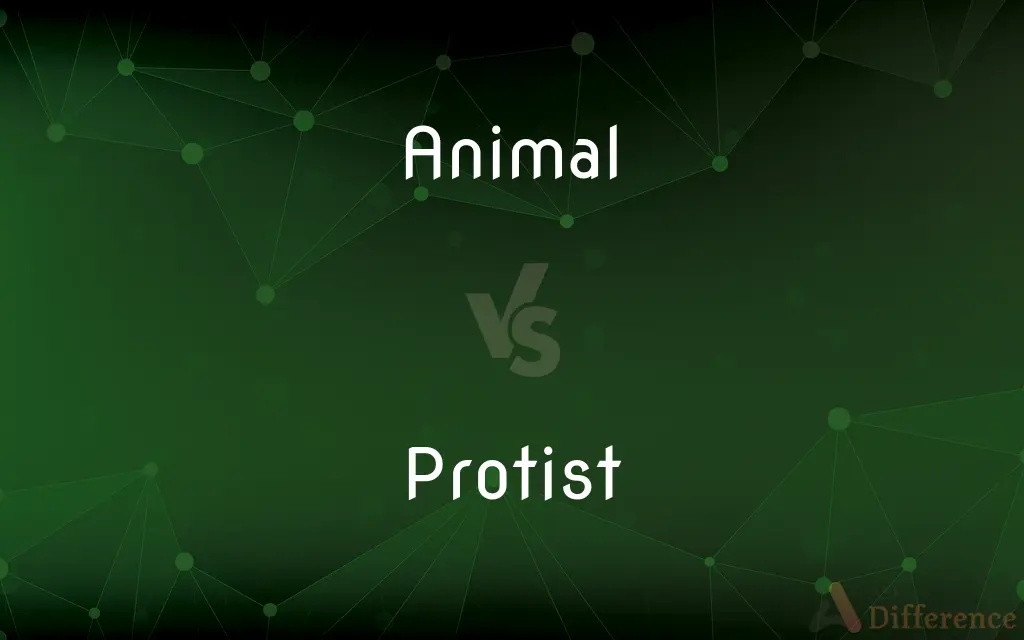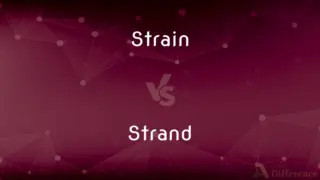Animal vs. Protist — What's the Difference?
By Tayyaba Rehman & Fiza Rafique — Updated on March 18, 2024
Animals are multicellular organisms with complex structures and behaviors, while protists are primarily unicellular, diverse organisms that don't fit into other kingdoms.

Difference Between Animal and Protist
Table of Contents
ADVERTISEMENT
Key Differences
Animals are characterized by their multicellular nature, heterotrophic lifestyle (obtaining food by ingestion), and ability to move at some point in their life cycle. They belong to the Kingdom Animalia and are distinguished by their complex tissue structure, including muscles and nerves, which allow for voluntary movement. Whereas protists are a diverse group of mostly unicellular organisms that belong to the Kingdom Protista. They can be autotrophic (producing their own food through photosynthesis) or heterotrophic and exhibit a wide range of living conditions and modes of reproduction.
The animal kingdom is well-known for its diversity, ranging from simple organisms like sponges to complex organisms like humans. This diversity is reflected in the vast array of habitats animals occupy and their various evolutionary adaptations. On the other hand, protists encompass an equally diverse group that includes algae, amoebas, and protozoa. Their diversity is mainly in their cellular structures and ecological roles, from being primary producers in aquatic ecosystems to parasites that affect humans and other animals.
In terms of their ecological roles, animals are primarily consumers within their ecosystems, playing crucial roles as predators, herbivores, and omnivores. Protists serve a variety of functions, from being key primary producers (e.g., phytoplankton) to acting as decomposers and parasites, thereby occupying various niches across almost all ecosystems.
While animals are often easily observable and have been studied extensively due to their size and complexity, protists, due to their microscopic size and diverse nature, require more specialized methods to study. This has led to a less comprehensive understanding of their full diversity and ecological impact compared to animals.
Comparison Chart
Kingdom
Animalia
Protista
ADVERTISEMENT
Cellularity
Multicellular
Mostly unicellular
Nutrition
Heterotrophic (ingestion)
Both autotrophic (photosynthesis) and heterotrophic
Movement
Often capable of voluntary movement
Varies, some are motile, others are stationary
Complexity
Complex tissue structure with organs and systems
Simple, often lacking complex tissues and organs
Ecological Roles
Consumers (predators, herbivores, omnivores)
Producers, decomposers, parasites, etc.
Diversity
Wide range of forms and sizes, from sponges to humans
Includes algae, amoebas, protozoa, etc., with diverse cellular structures
Compare with Definitions
Animal
Capable of voluntary movement at some life stage.
Butterflies undergo metamorphosis from stationary larvae to flying youngs.
Protist
Play key roles as primary producers, decomposers, and parasites.
Kelp, a type of large algae, forms underwater forests that provide habitat for marine life.
Animal
Occupy diverse ecological niches as consumers.
Sharks play a crucial role as top predators in marine ecosystems.
Protist
Can be autotrophic or heterotrophic, living in varied environments.
Algae produce oxygen and serve as the base of many aquatic food webs.
Animal
Kingdom Animalia members, characterized by complex, organized body systems.
Elephants are distinguished by their highly structured social behavior.
Protist
Diverse kingdom of mostly unicellular organisms that are not plants, animals, or fungi.
Amoebas are protists that change shape to move.
Animal
Multicellular organisms that eat organic material, breathe oxygen, and can move.
Lions are known for their predatory lifestyle.
Protist
Found in almost all ecosystems, including extreme environments.
Tardigrades, often mistaken for protists, can survive extreme conditions but are actually micro-animals.
Animal
A living organism that feeds on organic matter, typically having specialized sense organs and nervous system and able to respond rapidly to stimuli
Wild animals adapt badly to a caged life
Humans are the only animals who weep
Protist
A protist () is any eukaryotic organism (that is, an organism whose cells contain a cell nucleus) that is not an animal, plant, or fungus. While it is likely that protists share a common ancestor (the last eukaryotic common ancestor), the exclusion of other eukaryotes means that protists do not form a natural group, or clade.
Animal
Relating to or characteristic of animals
Animal welfare
The evolution of animal life
Protist
Any of numerous eukaryotic organisms that are not fungi, plants, or animals and are chiefly unicellular or colonial. Protists that are multicellular do not have cells differentiated into tissues. The protists include the protozoans, certain algae, oomycetes, and slime molds.
Animal
Relating to or denoting the pole or extremity of an embryo that contains the more active cytoplasm in the early stages of development.
Protist
(microbiology) Any of the eukaryotic unicellular organisms including protozoans, slime molds and some algae; historically grouped into the kingdom Protoctista.
Animal
Any of numerous multicellular eukaryotic organisms of the kingdom Metazoa (or Animalia) that ingest food rather than manufacturing it themselves and are usually able to move about during at least part of their life cycle. Sponges, jellyfishes, flatworms, mollusks, arthropods, and vertebrates are animals.
Protist
Single-celled eukaryotes, prokaryotes and sponges
Animal
An animal organism other than a human, especially a mammal.
Protist
Single-celled eukaryotes and prokaryotes
Animal
A person who behaves in a bestial or brutish manner.
Protist
Single-celled eukaryotes
Animal
A human considered with respect to their physical nature, as opposed to rational or spiritual nature.
Protist
One of the Protista.
Animal
A person having a specified aptitude or set of interests
“that rarest of musical animals, an instrumentalist who is as comfortable on a podium with a stick as he is playing his instrument” (Lon Tuck).
Protist
Free-living or colonial organisms with diverse nutritional and reproductive modes
Animal
Relating to, characteristic of, or derived from an animal or animals, especially when not human
Animal cells.
Animal welfare.
Animal
Relating to the physical as distinct from the rational or spiritual nature of people
Animal instincts and desires.
Animal
(science) A eukaryote of the clade Animalia; a multicellular organism that is usually mobile, whose cells are not encased in a rigid cell wall (distinguishing it from plants and fungi) and which derives energy solely from the consumption of other organisms (distinguishing it from plants).
A cat is an animal, not a plant. Humans are also animals, under the scientific definition, as we are not plants.
Animal
(loosely) Any member of the kingdom Animalia other than a human.
Animal
Any land-living vertebrate (i.e. not fishes, insects, etc.).
Animal
(figuratively) A person who behaves wildly; a bestial, brutal, brutish, cruel, or inhuman person.
My students are animals.
Animal
(informal) A person of a particular type.
He's a political animal.
Animal
, thing.
A whole different animal
Animal
Of or relating to animals.
Animal instincts
Animal
Raw, base, unhindered by social codes.
Animal passions
Animal
Pertaining to the spirit or soul; relating to sensation or innervation.
Animal
Excellent
Animal
An organized living being endowed with sensation and the power of voluntary motion, and also characterized by taking its food into an internal cavity or stomach for digestion; by giving carbonic acid to the air and taking oxygen in the process of respiration; and by increasing in motive power or active aggressive force with progress to maturity.
Animal
One of the lower animals; a brute or beast, as distinguished from man; as, men and animals.
Animal
Of or relating to animals; as, animal functions.
Animal
Pertaining to the merely sentient part of a creature, as distinguished from the intellectual, rational, or spiritual part; as, the animal passions or appetites.
Animal
Consisting of the flesh of animals; as, animal food.
Animal
A living organism characterized by voluntary movement
Animal
Of the appetites and passions of the body;
Animal instincts
Carnal knowledge
Fleshly desire
A sensual delight in eating
Music is the only sensual pleasure without vice
Animal
Of the nature of or characteristic of or derived from an animal or animals;
The animal kingdom
Animal instincts
Animal fats
Decaying vegetable matter
Common Curiosities
What roles do protists play in ecosystems?
Protists are primary producers, decomposers, and parasites, playing crucial roles in nutrient cycling and food webs.
What are the main differences between animals and protists?
Animals are multicellular, heterotrophic organisms with complex structures, while protists are mostly unicellular with diverse nutrition modes and simpler structures.
Can protists be considered plants or animals?
No, protists are a distinct kingdom of life, separate from plants, animals, and fungi, characterized by their diverse forms and life processes.
What is the significance of studying protists?
Studying protists is important for understanding biodiversity, ecological relationships, and the evolutionary history of life on Earth.
How do animals obtain their food compared to protists?
Animals obtain food through ingestion, acting as consumers, while protists can be autotrophic, making their own food, or heterotrophic, consuming other organisms.
Do all animals move?
Most animals have the ability to move at some point in their life cycle, though the extent and method of movement vary widely.
Can animals be found in the same habitats as protists?
Yes, animals and protists can share habitats, especially in aquatic environments where protists form a significant part of the food web.
Are all protists microscopic?
While most protists are microscopic, some, like certain algae, can be seen with the naked eye.
Why are protists not classified as plants or animals?
Protists are not classified as plants or animals because they possess unique characteristics that do not fit the criteria for these other kingdoms, such as their diverse modes of nutrition and reproduction.
What are some examples of protist diseases?
Malaria, caused by the Plasmodium protist, is a significant example of a disease caused by protists.
How do the cell structures of animals and protists compare?
Animals have complex cell structures with specialized tissues and organs, while protists generally have simpler, often unicellular structures without such specialization.
Share Your Discovery

Previous Comparison
Grafting vs. Layering
Next Comparison
Strain vs. StrandAuthor Spotlight
Written by
Tayyaba RehmanTayyaba Rehman is a distinguished writer, currently serving as a primary contributor to askdifference.com. As a researcher in semantics and etymology, Tayyaba's passion for the complexity of languages and their distinctions has found a perfect home on the platform. Tayyaba delves into the intricacies of language, distinguishing between commonly confused words and phrases, thereby providing clarity for readers worldwide.
Co-written by
Fiza RafiqueFiza Rafique is a skilled content writer at AskDifference.com, where she meticulously refines and enhances written pieces. Drawing from her vast editorial expertise, Fiza ensures clarity, accuracy, and precision in every article. Passionate about language, she continually seeks to elevate the quality of content for readers worldwide.















































